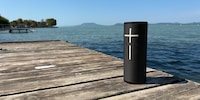

The Xtreme 4 from JBL is growing up(er)
JBL doesn't believe in keeping up with the annual iteration of its competitors. That's why the new Xtreme 4 comes three years after its predecessor. The popular outdoor Bluetooth speaker features numerous functional and acoustic innovations.
Sustainable, new, better? I want to scrutinise JBL's advertising promises and start with the core of every speaker: the music. The predecessor Xtreme 3 was primarily a bass monster. It made loud, powerful music that lacked a certain precision and balance. Will you have a déjà vu with the Xtreme 4? Yes and no. JBL has made improvements, but is sticking to the brand's "sound signature virtues".
The Xtreme 4 is slightly larger and wider than its predecessor, which can provide more resonance. On the inside, however, not much has changed in terms of hardware. Two 70-millimetre woofers, two 20-millimetre tweeters and the JBL-typical passive cones on the side. The Xtreme 3 had bass in abundance. JBL party sound as you know it. Important for you to know: All four drivers are "front firing" - so if you're standing behind the speaker, it's a fundamentally different listening experience.
How good the new speakers sound
I'll use three songs to explain what you can and can't expect from the sound of the Xtreme 4
"Hysteria" by Muse: very present but surprisingly controlled bass
As expected, the Xtreme 4 has a strong presence in the bass range. Low frequencies and bass are very pronounced. In my test, I first placed the speaker on a thin pressboard chest of drawers. The thin wood and the hollow contents showed a lot of resonance, i.e. they vibrated and thus displaced the slightly higher frequencies - the membranes on the side did their part.
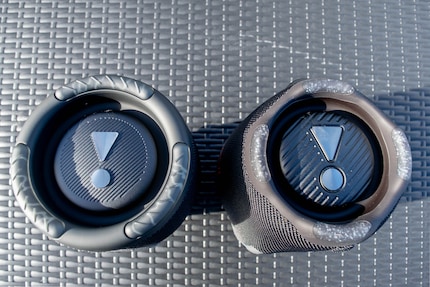
Source: Florian Bodoky
A solid piece of furniture is therefore recommended as a base. However, in contrast to the Xtreme 3, where the bass dominates everything else, the Xtreme 4 is more measured and adds a little warmth to the sound. My tip: If you are not only playing electronic beats, you should move the control in the first band of the equaliser down two to three levels. This will reduce the bass and prevent the bass from getting out of hand. This will make the sound more balanced. If you use the speaker outdoors, this is not absolutely necessary, even for bass-intensive songs. As you don't have any walls whose resonance amplifies the bass, the speaker automatically sounds more balanced.
"Spit it out" by Slipknot: full of energy, treble somewhat imprecise
The song by Slipknot actually shows the ideal purpose of the Xtreme 4. Fast, energetic and loud, the sounds resound from the speaker. As the focus of the song is not necessarily on precision, the weakness of the Xtreme 4 is not so noticeable here. Namely the precision of the treble. Especially when you turn the speaker up really loud, they get a little lost.
"The National Anthem" by Radiohead: no balance king, but the progress is audible
There's a lot going on in this Radiohead track. There are acoustic but also electronic sounds, it is fast, slow and has an ever-present bassline and vocals. A speaker can therefore excel here in terms of balance. We know that the Xtreme 4's strengths lie more in the lows and that the highs are somewhat lacking.
But JBL has clearly invested a lot of work in a balanced sound signature. Compared to its predecessor, the mids are easier to hear and are reproduced more correctly. Here, too, the quality decreases at very high volumes - but up to around 70 per cent of the maximum (and that is already very, very loud), the Xtreme 4 really shines.
The app: not a must
When we talk about bass sound, the equaliser in the app also becomes a topic. But be careful when choosing an app! JBL offers several. I found a total of seven in the App Store. Soundbars, headphones, portables - all are listed separately. The app you need for the Xtreme 4 is called JBL Portable - it's available (for Android and iOS).
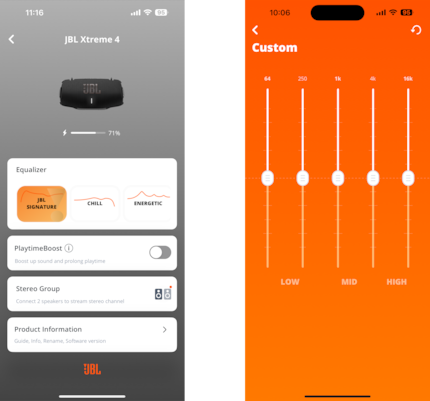
Source: Florian Bodoky
JBL keeps the app and its functions clear. The most important thing: There is an equaliser where you can adjust the highs, mids and lows - five bands between 64 Hz and 16 KHz. There are also four presets to choose from. Energetic, Chill, Vocal and JBL Signature. The latter is unmistakably bass-heavy.
There is also the "PlaytimeBoost" mode. This makes the sound louder, but thinner. I use it when things have to get really loud and the quality is less important. However, the equaliser settings or presets are then deactivated. Otherwise, you can connect several speakers together in the app and download firmware.
My opinion: The equaliser helps to dampen the bass a little more. If you want that, you can get the app. Otherwise, you don't really need it.
Proven values: the design and feel have only undergone a gentle renovation
A comparison with the predecessor is striking: Not everything is completely new. The design and shape are only subtly different. The Xtreme 4 is slightly thicker and larger than the Xtreme 3, but only around 200 grams heavier, which is manageable when carried with the included carrying strap. The Xtreme 4 weighs 2.1 kilograms and the reason for the 1.2 centimetre increase in size is the slightly larger footprint of the Xtreme 4, which makes it much more stable - a definite advantage on wobbly outdoor surfaces. Also back in the game: the gigantic, JBL-branded passive membranes on the sides.
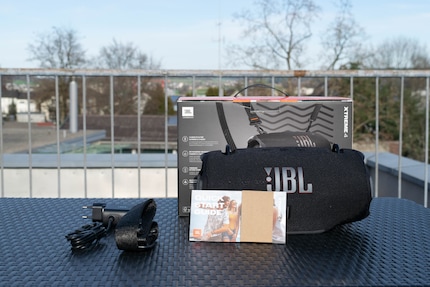
Source: Florian Bodoky
Another design change can be found on the control panel: Instead of organising all the buttons in a row, JBL has now divided the buttons into a "music control" and a "device control". New: the Auracast button. Auracast is a new transmission technology based on low-energy Bluetooth. Put simply, you can use a transmitting device - such as a smartphone or TV - to send audio streams to an unlimited number of audio receiving devices, e.g. headphones or speakers.
With the Xtreme 4, you can distribute several speakers in a larger room or even in separate rooms and provide sound from a centrally controlled device. Or you can choose the TV in the sports bar whose sound is sent to your headphones - so that you can listen to the football commentary on the game being shown on the selected TV without disturbing another guest with the noise, for example.
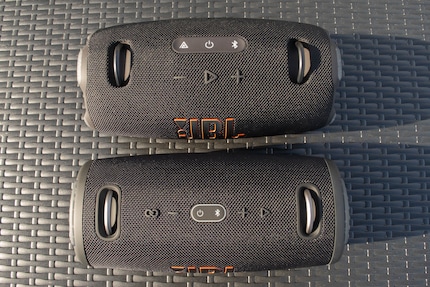
Source: Florian Bodoky
JBL has slimmed down at the back: the Xtreme 4 only has a USB-C port for charging the speaker. JBL also includes a power adapter with an interchangeable plug - so you can connect a Schuko plug or other plug instead of the Euro standard. The port can not only receive power, but also provide energy: If you connect your smartphone to it, it will be charged. The manufacturer has also included a USB-A and a jack port in the three-pin version. The Xtreme 4 also supports Multipoint, meaning it can be connected to multiple players at the same time.
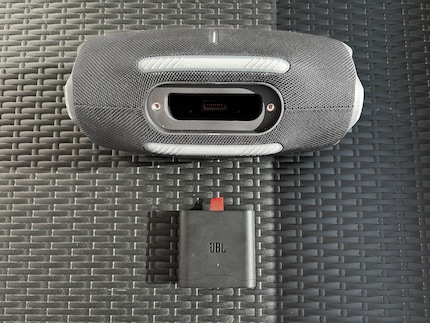
Source: Florian Bodoky
The highlight is on the underside of the Xtreme 4: the screwed-in battery slot. You can use a star-shaped (Torx) screwdriver to gain access and then simply pull the module out of the slot. This allows you to replace it if necessary. The shaft cover is made of rubber and is screwed on quite tightly. It has to be, because like its predecessor, the Xtreme 4 is protected against water to IP67. It is therefore still suitable for outdoor use.
Battery performance: even more hours, even faster charging
The upgrade to the battery power of the new Xtreme is just as useful as it is unspectacular. The speaker lasts up to 24 hours. Compared to its predecessor, this is an increase of around 8 hours. Something that I can roughly confirm after intensive testing. After a measured playtime of 23 hours and 37 minutes, the Xtreme 4 said goodbye.
I would recommend that you charge it again if possible when the first "low battery" warning appears. The new Fast Charging works well so far. Ten minutes on the power, two more hours of partying.
In a nutshell
More mature sound, but still a party speaker
One thing is clear: the Xtreme 4 from JBL is - like its predecessors - a party speaker. Even if it has its bass under better control and the general balance has improved. So if you want to indulge in violin virtuosos at home with a cognac and a cigar, you should probably choose a different speaker.
But if you are looking for a portable speaker with extremely high sound quality and robustness, then you should go for this one.
Pro
- Bass-heavy, but still good sound
- Very good processing quality
- Auracast
Contra
- No more jack port
- Relatively clunky

I've been tinkering with digital networks ever since I found out how to activate both telephone channels on the ISDN card for greater bandwidth. As for the analogue variety, I've been doing that since I learned to talk. Though Winterthur is my adoptive home city, my heart still bleeds red and blue.
